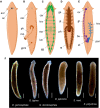Planarian nociception: Lessons from a scrunching flatworm
- PMID: 35959107
- PMCID: PMC9362985
- DOI: 10.3389/fnmol.2022.935918
Planarian nociception: Lessons from a scrunching flatworm
Abstract
In addition to being studied for their exceptional regeneration abilities, planarians (i.e., flatworms) have also been extensively used in the context of pharmacological experiments during the past century. Many researchers used planarians as a model system for the study of drug abuse because they display high similarities with the nervous system of vertebrates at cellular and molecular levels (e.g., neuronal morphology, neurotransmitter ligands, and receptor function). This research field recently led to the discovery of causal relationships between the expression of Transient Receptor Potential ion channels in planarians and their behavioral responses to noxious stimuli such as heat, cold or pharmacological analogs such as TRP agonists, among others. It has also been shown that some antinociceptive drugs modulate these behaviors. However, among the few authors that tried to implement a full behavior analysis, none reached a consensual use of the terms used to describe planarian gaits yet, nor did they establish a comprehensive description of a potential planarian nociceptive system. The aim of this review is therefore to aggregate the ancient and the most recent evidence for a true nociceptive behavior in planarians. It also highlights the convenience and relevance of this invertebrate model for nociceptive tests and suggests further lines of research. In regards to past pharmacological studies, this review finally discusses the opportunities given by the model to extensively screen for novel antinociceptive drugs.
Keywords: TRP ion channels; animal model; behavior; drug screening; invertebrate; nociception; opioids; planarians.
Copyright © 2022 Reho, Lelièvre and Cadiou.
Conflict of interest statement
The authors declare that the research was conducted in the absence of any commercial or financial relationships that could be construed as a potential conflict of interest.
Figures


Similar articles
-
Behavioral and pharmacological characterization of planarian nociception.Front Mol Neurosci. 2024 May 1;17:1368009. doi: 10.3389/fnmol.2024.1368009. eCollection 2024. Front Mol Neurosci. 2024. PMID: 38751713 Free PMC article.
-
Pharmacological or genetic targeting of Transient Receptor Potential (TRP) channels can disrupt the planarian escape response.PLoS One. 2019 Dec 5;14(12):e0226104. doi: 10.1371/journal.pone.0226104. eCollection 2019. PLoS One. 2019. PMID: 31805147 Free PMC article.
-
Planarian Scrunching as a Quantitative Behavioral Readout for Noxious Stimuli Sensing.J Vis Exp. 2020 Jul 30;(161). doi: 10.3791/61549. J Vis Exp. 2020. PMID: 32804171
-
[Regeneration of planarians: experimental object].Ontogenez. 2015 Jan-Feb;46(1):3-12. Ontogenez. 2015. PMID: 25898529 Review. Russian.
-
Neuropharmacology and behavior in planarians: translations to mammals.Comp Biochem Physiol C Toxicol Pharmacol. 2008 May;147(4):399-408. doi: 10.1016/j.cbpc.2008.01.009. Epub 2008 Feb 1. Comp Biochem Physiol C Toxicol Pharmacol. 2008. PMID: 18294919 Review.
Cited by
-
Neurophysiological measurements of planarian brain activity: a unique model for neuroscience research.Biol Open. 2024 Aug 15;13(8):bio060480. doi: 10.1242/bio.060480. Epub 2024 Aug 8. Biol Open. 2024. PMID: 38979914 Free PMC article.
-
Planarian RNAi knockdown: feeding once might just be enough.Front Neurosci. 2025 Apr 30;19:1546196. doi: 10.3389/fnins.2025.1546196. eCollection 2025. Front Neurosci. 2025. PMID: 40370667 Free PMC article.
-
Behavioral and pharmacological characterization of planarian nociception.Front Mol Neurosci. 2024 May 1;17:1368009. doi: 10.3389/fnmol.2024.1368009. eCollection 2024. Front Mol Neurosci. 2024. PMID: 38751713 Free PMC article.
-
Ultrastructural analysis and 3D reconstruction of the frontal sensory-glandular complex and its neural projections in the platyhelminth Macrostomum lignano.Cell Tissue Res. 2024 Aug;397(2):147-177. doi: 10.1007/s00441-024-03901-x. Epub 2024 Jun 20. Cell Tissue Res. 2024. PMID: 38898317
References
Publication types
LinkOut - more resources
Full Text Sources
Miscellaneous

